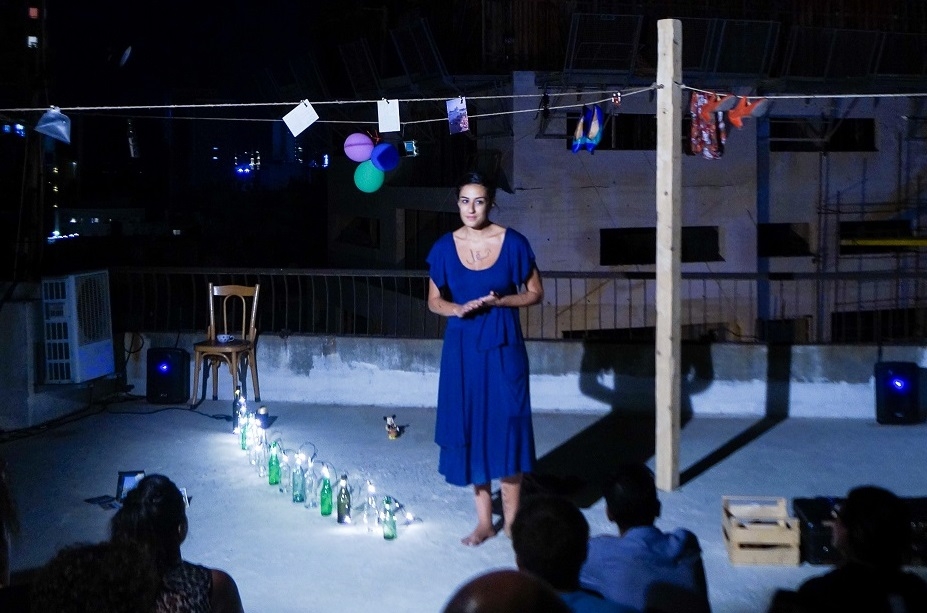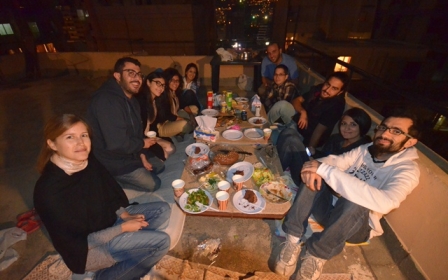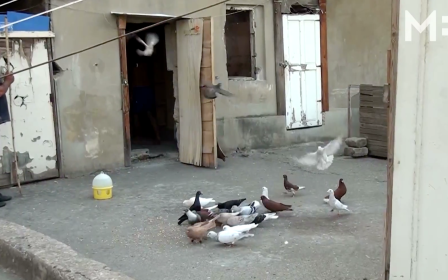The moon, the neighbours and us: People's art in Beirut

When the funders of the Kahraba Collective rented a rehearsal place on the Vandome staircase in Mar Milkhail, a close-knit popular quarter whose urban and social landscape is being overturned by private investments, they did not imagine they would one day transform it into the setting of an open-air, free artistic festival.
The neighbourhood used to be home to the Vandome Cinema, a landmark of Beirut’s cultural heritage, torn down in 2011 to make space for the 30-story AYA tower, currently under construction. The cinema is only one of Beirut’s many artistic and cultural hotspots that have fallen victim to real estate agents. The sweeping wave of demolition and privatisation is making access to cultural spaces unaffordable to performers as well as a large share of the population.
Amid these daunting changes, the Kahraba Collective has made a point of bringing art back to the people. At first, they focused on performing in remote and disadvantaged areas of Lebanon, but it soon became clear that they were looking too far.
“We noticed the neighbours’ curiosity for what was happening behind our closed doors,” says Aurelien Zouki, co-founder of the collective, “so we invited them to see our performances. Soon they started coming along with their friends and we realised that these gatherings had the potential to grow into something bigger.”
The festival Nahna wel amar wel jiran (The moon, the neighbours and us), which started this year on 28 August, developed physiologically as a single response to two sets of problems: the inaccessibility of artistic spaces to both the public and the performers and the fragmentation of Lebanese society.
“In these three days of the festival we live the utopia of a world where art is for everyone and people from all walks of life come together with no economic, religious or cultural divides,” says Zouki.
Bringing art back to the people
Now in its fourth year, Nahna wel amar wel jiran saw the participation of 20 artists – both local and international - and over 90 volunteers, who offered their time free of charge in order to create an event truly accessible to everyone.
Performances take place amid the sounds of the city, still bustling with life as the spectators are plunged into a different reality. Passers-by stop to join the show, taken aback by the sudden appearance of art beyond its designated setting, while a few heads appear on the overlooking balconies.
Lebanese actress Yara Bou Nassar participated in the festival for the third time this year, performing on the rooftop of one of the quarter’s traditional houses. The profile of the AYA tower, dauntingly appearing in the background, is the natural setting for her theatre piece, in which she recounts the mixed feelings that Beirut inspires in its inhabitants.
“How many of the old abandoned houses have not been torn down yet? How many waves in the sea have not been bought yet? How many people still notice the bullet traces all around the city? How much sky will we still see through the cement and concrete corners?,” she recites in her play while hanging on a rope the objects that exemplify her dearest memories.
“Beirut, if people ask I will answer, I am searching for human value among other things...”
According to Bou Nassar, the festival, made a reality by volunteers, a crowdfunding campaign and the support of sponsors, is the perfect example of how Lebanese artists are coming up with innovative solutions to bridge the gap between people and art.
For those who belong to the older generation, Nahna wel amar wel jiran represents one of the few opportunities to experience the performing arts. The civil war has left its scars in the predominantly Christian neighbourhood of Mar Mikhail and few of its elder inhabitants would venture in the Muslim areas of Tayoune or Hamra, where the main theatres are located.
By offering free, open-air performances, the festival succeeds in breaking those economic and social barriers that have made Beirut’s arts scene inaccessible to many. When planning its realisation, however, the Kahraba Collective had to take into consideration the nature of the space in which they were going to perform, in between public and private.
Nawal al Haber has seen three generations grow up playing on the brightly painted Vandome stairs. For her, the spaces used for the performances – the parking lot, the public school, the garden – tell the story of her community.
“At first, the idea of having a crowd in our neighbourhood worried us,” says Haber, describing how the neighbourhood is still a village within the city. “Now I look forward to the festival. It makes me happy to see people come together with the spirit of sharing.” Like most of the neighbours, every year she turns her home’s patio into a restoration point, selling mana’ushe at the most affordable price.
Welcome to the festival, whoever you are
Praline Gay Para, one of the performers in the festival, has spent her life collecting stories. While other storytellers focus on their own cultures, she archived decades of popular tales from the four corners of the world. Those she selected for the festival carry a plea of tolerance to the country she fled from during the blood-soaked years of the civil war.
Together with tales from Lebanon’s main cultural minorities – Armenian and Palestinian - she chose to present one from Ethiopia. “Sadly, Lebanese society is still profoundly racist,” says Gay Para, explaining that many domestic workers in Lebanon are Ethiopian. “These people are the ones building this country. I wanted to show the Lebanese that they do have a culture, maybe even greater than ours.”
According to Gay Para, storytelling has the power to bridge the gap between different cultures. “The Carribean tale of the greedy king who wants to reach the moon strikes a chord among the Lebanese because they immediately relate it to the proliferation of skyscrapers in Beirut,” she says, adding that it doesn’t matter to the audience how far away these tales originate from. “They told me, 'this is our story'.”
Another performance brought on the scene the plight of the Syrian refugees, who have long passed the one million landmark in Lebanon. Tota Tota…and the Story Begins narrates the story of Hadi, who looses his memory in Damascus only to find himself stranded in Beirut three years later.
Ayman Assayed, one of the actors in the play, experienced first-hand the hardship of resettling in Lebanon. Since his arrival from the Palestinian camp of Yarmouk, located at the periphery of Damascus, he was repeatedly arrested by the Lebanese authorities and pressured to leave the country.
“I was treated as a terrorist and I was persuaded that I would always be marginalised,” he remembers. “Working on this play together with Palestinians, Syrians and Lebanese has healed my image of Lebanon.”
Together with Tota Tota, the Kahraba Collective also contributed to the realisation of a dance performance by youths from the Palestinian refugee camp of Ain el Hilweh – the biggest and most unstable in the country – and a play featuring the hardships of Ethiopian migrant workers in Lebanon.
Despite having to fund their presence in Beirut, 15 international artists also joined the festival this year – a number that is on constant rise. “This event is something unique in its kind,” says Luigi Biondi, who came from Italy to curate the dance performance L’Incontro. “In other festivals they end up spending absurd amounts of money and the end result is not nearly as good as this.”
International curators, directors and producers have also come to Beirut to take part in the encounters organised by the Kahraba Collective to promote Lebanese talent and create a fertile ground for international collaboration.
“What we created should be considered normal, rather than militant,” says Aurélien Zouki during one of the few breaks in weeks of hectic preparation. “In the end, this festival is a parenthesis that shows people how our society might be, if only we realised that we are all of the same nature.”
Middle East Eye propose une couverture et une analyse indépendantes et incomparables du Moyen-Orient, de l’Afrique du Nord et d’autres régions du monde. Pour en savoir plus sur la reprise de ce contenu et les frais qui s’appliquent, veuillez remplir ce formulaire [en anglais]. Pour en savoir plus sur MEE, cliquez ici [en anglais].





